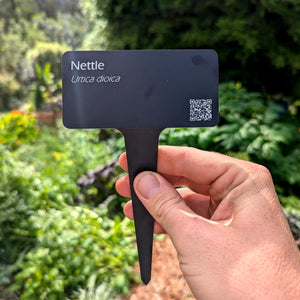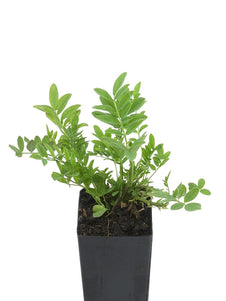







Goat's Rue
Goat's Rue

- Low stock - 10 items left
- Inventory on the way

Usually available: All year
Life cycle: Perennial
Height: 30cm - 1.2m
Position: Sun / part shade
Soil preference: Moist / well drained
This is how we pack and send your Herb Plants to all states except TAS & WA
You will receive
- 1 Goat's Rue Herb Plant in a 50 X 75mm tube - General growing instructions
All of our Herb Plants are grown organically with certified organic potting mixes and fertilizers
Botanical Name: Galega officinalis
Goat’s rue is an herbaceous perennial, growing up to 1.2 meters by 75cm wide. This vigorous, bushy plant has bright green compound leaves, each with 13-17 lance shaped leaflets that are approximately 2-5 cm long. The white to pink - lilac flowers give way to the seed pods, which hold 2-6 kidney shaped seeds. The erect, branching stems are smooth and hollowed and support the long floral stalks. Goat’s rue flowers in summer, is a bee attractant and a food plant for the larva of some moth species.
Goat’s rue is also known as French lilac, Italian fitch or professor weed. The genus name Galega is derived from ‘gale’ meaning milk and ‘ega’ meaning ‘to bring on’. This is a reference to the use of goat’s rue to encourage the milk flow of small animals, such as goats. This value was first noted by farmer, Gillet Daimitte, in a letter to the French Academy in 1873. The letter contained details of a 35-50% increase in milk yield, after feeding goat’s rue to the dairy animals.
Goat’s rue is extensively cultivated as a forage crop. In 1891, goat’s rue was introduced as a forage crop in Utah, where it escaped cultivation. It is considered a noxious weed in the United States but no new specimens have been found since the 1960s. The plant has been found as far south as New Zealand. Goat’s rue is considered safe, but was accidentally discovered to be toxic after the death of sheep that had consumed largequantities. It is unknown exactly why these sheep succumbed while other animals remain unaffected.
The plant was originally found in the Middle East, and perhaps in Europe, Asiatic Russia and Iran. It has become naturalised in Europe, Western Asia and Western Pakistan.
Note that there is another plant called ‘goat’s rue’, Tephrosia virginiana, used as a fish poison. All parts of this plant are toxic to humans and animals and must not be consumed.
Growing Conditions
The primary habitat of goat’s rue is wet, damp meadows, river banks or any low lying damp soils. Moist soil is preferred, although goat’s rue can grow in many soil types, including nutrient poor ground. It is also able to grow within coarse grass, such as animal pastures, and be cut in autumn. Where growing conditions are good the plant may become invasive and it is very long lived.
Propagation is by seeds, soaked in warm water for 12 hours. In warm areas, seeds may be sown directly into the ground and selectively thinned. In colder areas, sow into seed trays and plant out seedlings when the ground is warmer. The seedlings will divide to fill the space they are given. Alternatively, they can be grown from cuttings or clumps may be divided and replanted.
Goat’s rue is a leguminous plant of the pea family, so it uses bacteria to fix nitrogen, found in the root nodules. The plant uses most of this nitrogen, but there is some available to other plants in surrounding the area.
Flowers, stems, leaves and seeds may all be harvested, dried and used. Dry in the shade and store in an airtight container.
Culinary Uses
In some parts of Europe goat’s rue is called ‘cheese rennet,’ because the juice pressed from the green parts of goat’s rue is used to clot the milk during cheese processing.
Medicinal Uses
Goat’s rue has been used for centuries as a protective measure for those who suspect they may be prone to diabetes. Its value was found in the guanidine content of goat’s rue. This substance is toxic for humans, but does lower blood sugar. Human trials in the 1920-1930’s found galegine which was less toxic, but ineffective. However, these trials were a major milestone and instrumental in beginning the research pathway that lead to the discovery of metformin, commonly used to treat ‘modern’ diabetes.
The active ingredients are flavonoids, saponins, glycosides, tannins and galegin. Today people still use this plant as a protectant against diabetes in combination with diet and exercise. However the active constituents may interfere with diabetic medication. Stop using goat’s rue 2 weeks before surgery, due to the possible effects on blood sugar levels during surgery and recovery.
Historically, people used goat’s rue, combined with other herbs, as a general tonic and for ‘blood purification’. Some communities used it for a snake bite remedy, to treat plague and intestinal parasites. Other traditional uses for goat’s rue include use for its diuretic properties, as a stimulant for adrenal glands and pancreas, to protect the liver, for digestive problems, diaphoretic properties and to start the flow of breast milk.
Goat’s rue is also used by today’s mothers as a lactation stimulant and its effectiveness is discussed regularly by women on parenting forums. The effectiveness is undetermined and the effect on breastfeeding babies is unknown.
A simple infusion is made by using a teaspoonful of dried leaves in a cup of boiling water. Steep for 10-15 minutes, then strain and cool before drinking twice per day.
All information provided on this website is for informational purposes only. Please seek professional advice before commencing any treatment.






